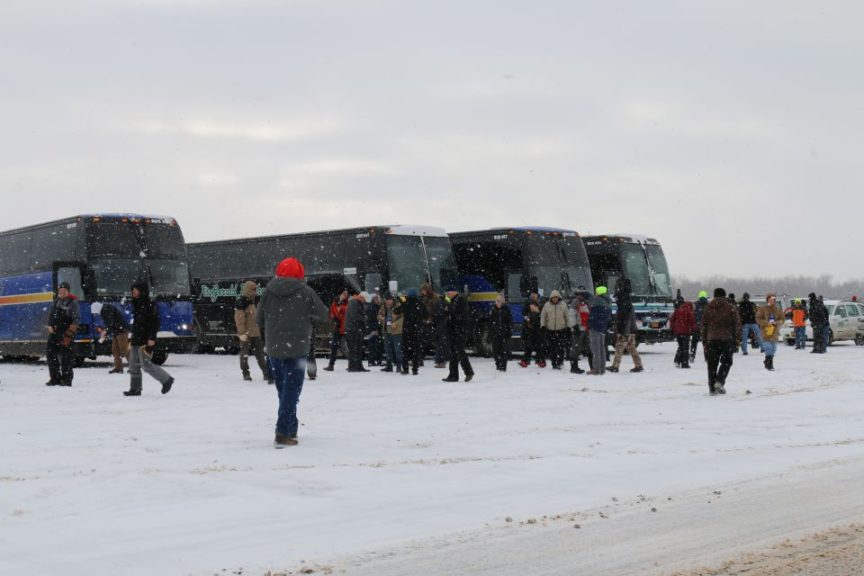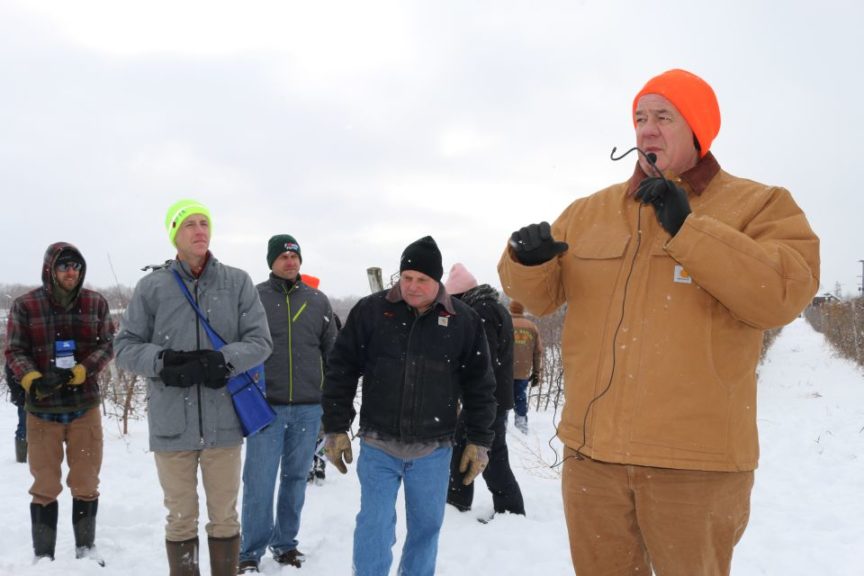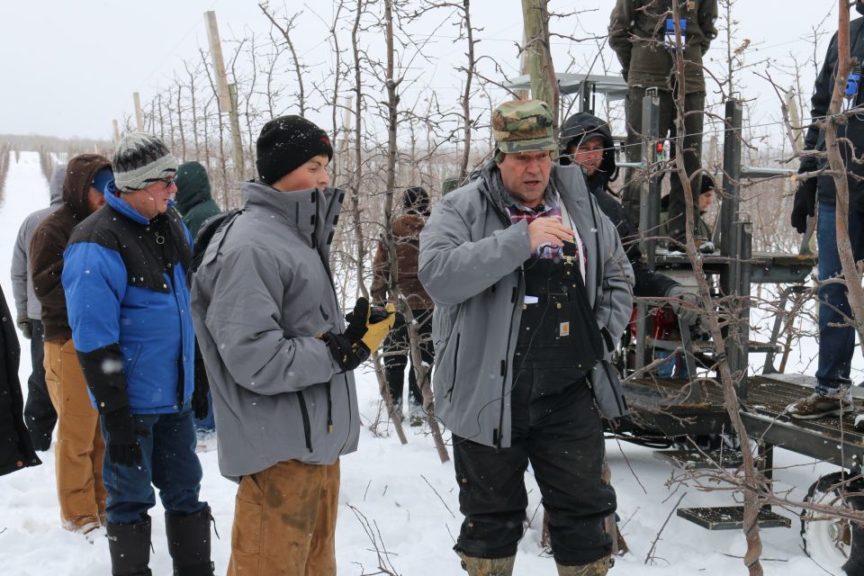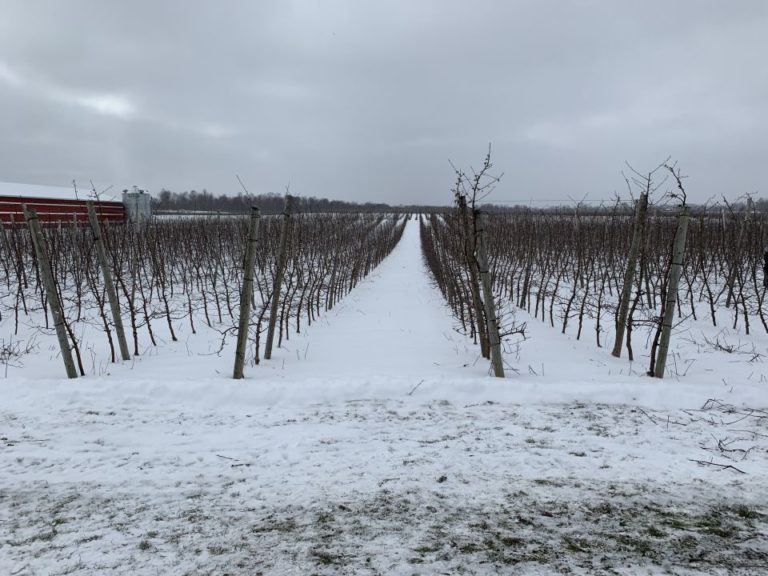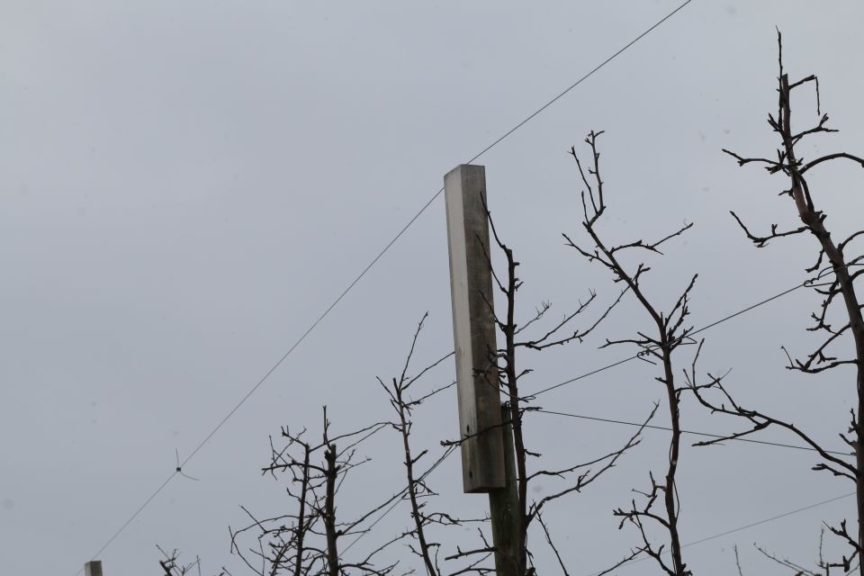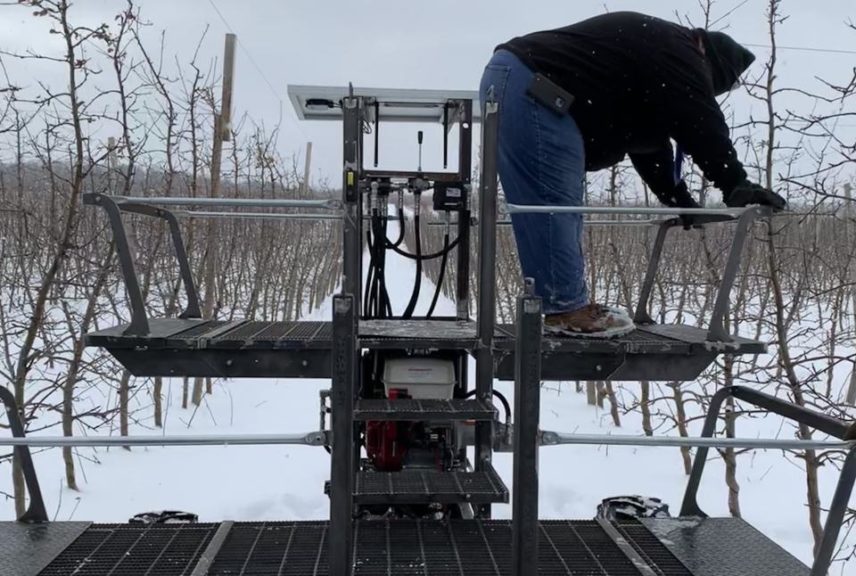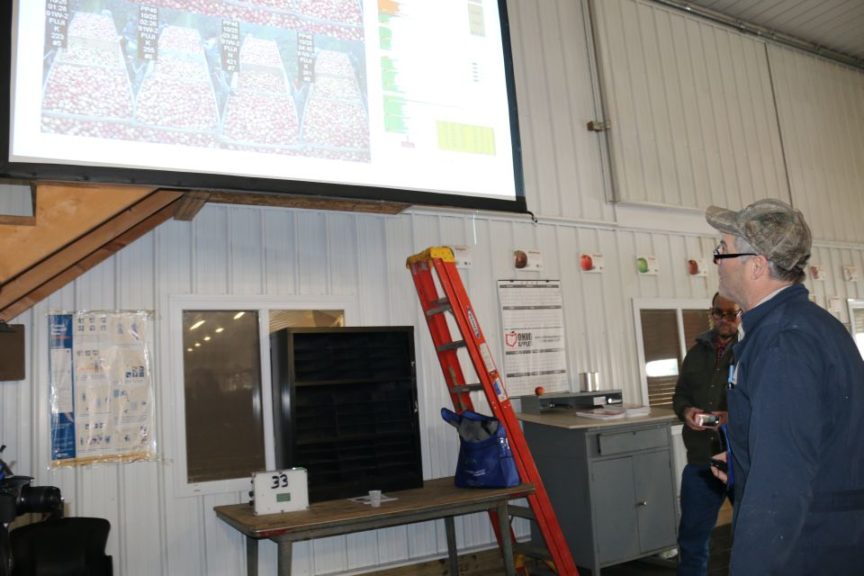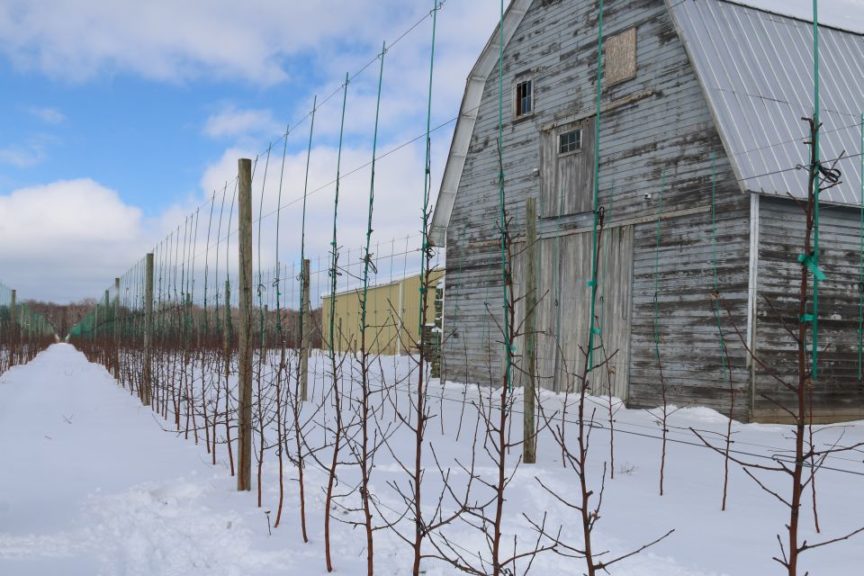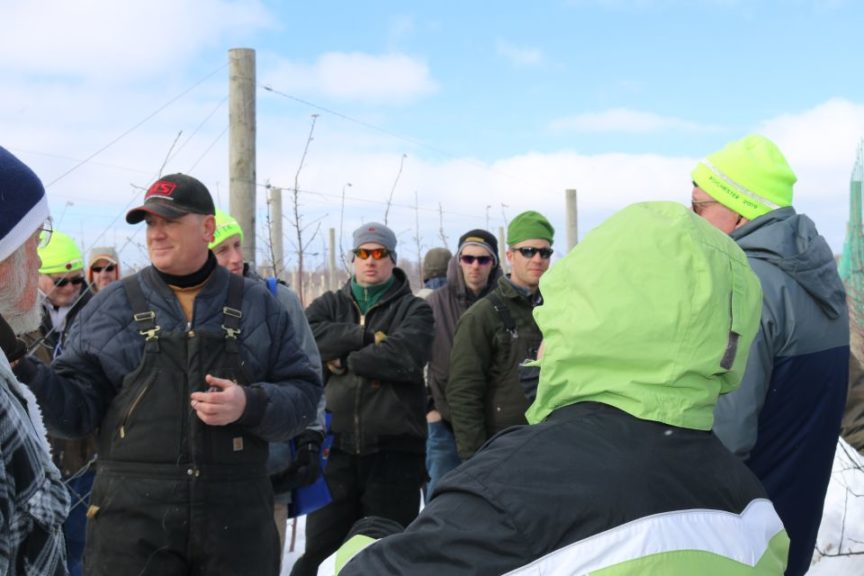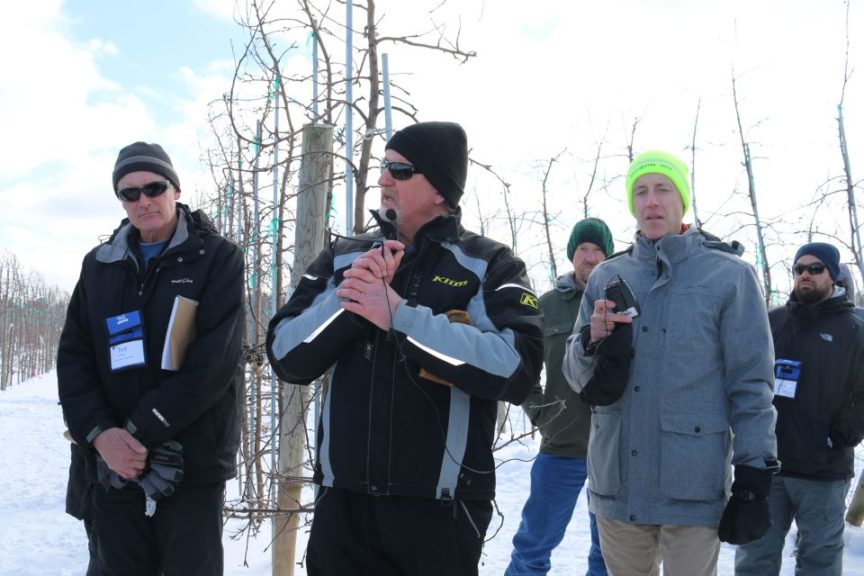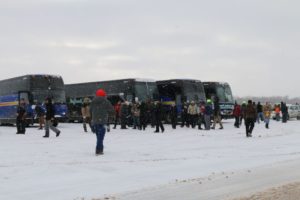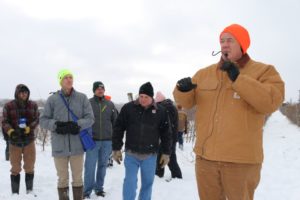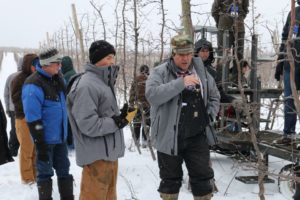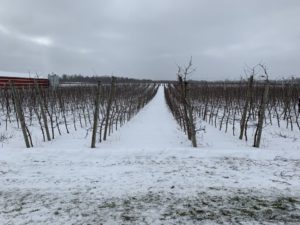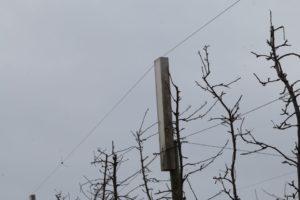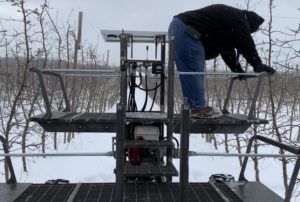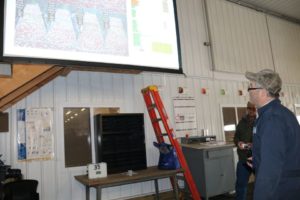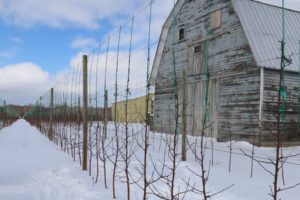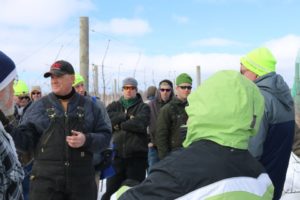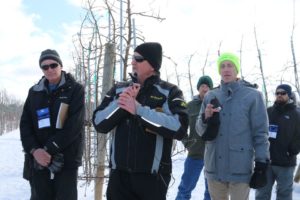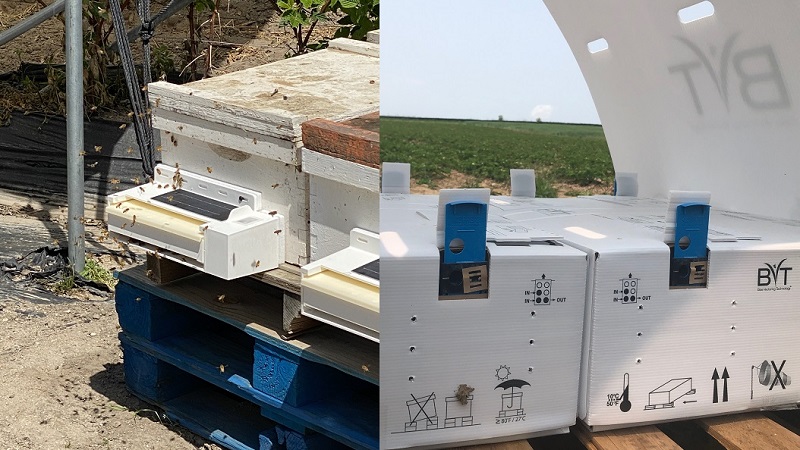Insights from IFTA Tour Could Give Your Orchard a Boost
Growers on the last day of tours during the 2019 International Fruit Tree Association (IFTA)’s annual conference in Rochester, NY, got a good look at how Fowler Farms operates as a vertically integrated farm.
“We can control everything from start to finish and manage our destiny,” J.D. Fowler says.
Fowler says the family transitioned to a super spindle system in the early 1990s, and it was an easy decision.
“At that time, we had every system but that one,” Fowler says, noting they were all hard to manage or produced apples of poor quality. “We haven’t looked back.”
The goal with moving to one system was to standardize and boost production.
“We can double and triple [the leaders] and do all right because of the ease of training,” Fowler says, noting the twin leaders help control the vigor from their M.9 rootstock.
Trees are 10 feet-by-2.5 feet and the goal is to keep trees to 8 or 9 feet tall. Fowler says “we’re afraid of heights.” His workers are happier and more productive without platforms for training and trellising.
“We’ve tried it and we can’t hardly beat the guys on the ground,” he says.
Planting is done in the fall, around the first part of October. The goal is to get the trees to shut down before winter. An added bonus, Fowler says, is their crews have all winter to get poles in.
They’re planting ‘Honeycrisp,’ ‘EverCrisp,’ ‘NY-1,’ ‘NY-2,’ ‘Gala,’ ‘Fuji,’ ‘Empire,’ and ‘SweeTango,’ but will maintain their current planting spacing.
“We would have to go wider and higher to increase yields,” Fowler says. But with equipment they’ve purchased, “we’re kind of stuck.”
The Fowlers are looking at multileader ‘EverCrisp’ with two or three leaders, about 3 to 3.5 inches apart. There’s a wire per leader for support, and the trees are in their third leaf. Drip irrigation runs along the bottom of the planting.
“I think it’ll keep them a little calmer,” Fowler says.
Terence Robinson of Cornell University says he’s encouraged the Fowlers to look at going taller with trees.
“JD and I, I wouldn’t say argue, but we talk a lot about going higher,” he says.
The Fowler family is also working with Helena to develop soil mapping. This process uses electromagnetic field manipulators. This data helps with fine-tuning fertilizer applications and to better understand the soil variability that exists beneath the orchard.
Robinson says they’re learning that fruit size is strongly tied with potassium. And, not all of what’s applied in the ground is readily available to the tree. A delicate balance, though, is for ‘Honeycrisp’ where large amounts of potassium can exacerbate the symptoms of bitter pit. Robinson cautions growers to not rachet down potassium, just to avoid bitter pit.
“You have to find that happy medium,” he says. “If your soil needs potassium, don’t be afraid of it.”
Wafler Farms, Inc.
“Two things I like are equipment and caffeine,” was one of the many Paul Wafler-isms shared during the IFTA Conference’s tour stop at Wafler Farms, Inc., and Wafler Nursery in Wolcott, NY.
And, after spending a bit of time with Paul Wafler, tourgoers could see why he favors caffeine and especially equipment.
Wafler is working with Agrinetix, LLC, on software they call “Apple Pi” to work with Wafler’s platforms. Computer boxes mounted on Huron Fruit Systems platform film trees to help look at fruit sizing. The sizing data gathered is applied to a grid of the orchard’s soil structures in Apple Pi. The software can print out RFID tags based on soil type to help track bitter pit. All of this is designed to develop a more productive orchard.
“I’m a little more real in what my size is going to be,” he says.
Cameras are also mounted on the platforms to monitor workers during harvest. Wafler says at any time he has 15 or 16 platforms running in the orchard at once. So, accountability is important. He looks for areas where workers could improve picking speed, color picking accuracy, bag transfer, etc. This camera system also helps keep track of picking speed and knowing where crews begin and end.
“You’re recognized all the time,” Wafler says, noting the cameras also help his team identify good work and workers. It’s not all just a critique; this helps workers learn from one another.
Wafler says he usually runs a six-man crew and can pick about 600 fresh apple bins a day, and by streamlining bin transfer, he’s been able to reduce down time at harvest.
“We just keep trying to find a new mouse trap,” Wafler says.
Paul’s son, Kyle, spoke with growers out in his family’s orchard, where tourgoers got another chance to see the tall spindle tip system, where trees in 12-foot-wide rows are tipped in. Workers can pick apples through completely, using platforms. Trees are about 3.2 feet apart on B.9 and are angled anywhere from 8 to 10 degrees.
Paul Wafler has even designed a smaller platform for orchard tasks to run in the 7-foot narrow row that is tipped out.
The first tall spindle tip was planted in 2010. Wafler Farms has about 250 acres planted in this system, yielding about 1,400 bushels per acre.
“We like the V because we’re catching light,” Kyle Wafler says.
VanDeWalle Farm, LLC
VanDeWalle Fruit Farm in Williamson, NY, is constantly focused on orchard renewal, while also trying to stay ahead of the variety planting curve.
“The shift in varieties was so fast we couldn’t keep up,” says Scott VanDeWalle of the shift from older traditional varieties to newer varieties like ‘EverCrisp,’ ‘Sweet Cheeks,’ and ‘SweeTango.’
He says “there’s a lot of pain coming” with people jumping on the bandwagon of managed varieties.
“We’re going to keep planting because that’s what we do and hope we pick the right variety,” he says.
VanDeWalle has an in-house nursery. Budding is done in August with about a 99% success rate. He likes ‘Fuji’ on B.9, ‘SweetCheeks’ on M.9-337, ‘Gala’ on B.9, and ‘Honeycrisp’ on either M.9-337 or B.9.
“I tread carefully on planting new rootstocks,” he says. “It’s a generational shift. There’s enough risk in this business. I know what I can get off a B.9 and an M.9.”
Two-year-old nursery trees are planted 28 inches apart by 10 feet. Trees are planted with a Phil Brown Welding four-row planter with GPS. He says keeping the trees close has boosted his yields and, in turn, revenue.
“Those extra trees generated $300,000 in revenue,” he says.
“We don’t mess around with fire blight,” he says. “If it’s 60°F and 60% humidity at bloom, we spray.”
VanDeWalle notes a program of Regalia (Marrone Bio Innovations) and Actiguard 50WG (Syngenta U.S.) “can’t hurt.”
Crews start mechanical hedging in the third leaf.
“I want a vertical wall, but the old guy in me trims to conical,” he says.
As far as looking to the future, VanDeWalle says he’d like to move his operation toward a more pedestrian orchard, with trees about 8 feet tall.
“I’m always chasing something,” he says. “Sometimes I think I’m chasing my tail.”
VanDeWalle uses Munckhof 3-Row Orchard Sprayer, which he says has boosted efficiencies.
“Do what you know in your orchard,” he tells growers.
Cherry Lawn Fruit Farms, LLC
Todd and Ted Furber of Cherry Lawn Fruit Farms, LLC are fourth-generation farmers, whose operation will be a century farm in 2022.
The Furbers still have processing apples as well as fresh plantings.
As far as the processing apples, “the reason they’re still there is they’re still getting good yields,” says Todd Furber.
The Furbers have moved toward DrapeNet to protect their fresh apples against hail. The storm that pushed the Furbers toward protective netting had hail 20 to 25 millimeters in diameter and led to 100% loss.
“It all went to juice,” Todd Furber says, noting “we don’t want to lose shelf space.”
They’ve installed hoops to keep the netting off the trees. There are also fiberglass rods to support the individual trees in the planting. In their ‘SweeTango’ blocks, the weight of the netting has affected the tops of the trees. It’s guaranteed to last for at least eight years.
The goal with picking is to be able to walk four rows at a time picking, Todd Furber says.
But, as Ted Furber notes, “It’s not fun to pick around hail.”
The Furbers are also using Extenday reflective cloth to also promote more color, especially on trees that are netted.
“I saw it being used in New Zealand, so why not here?” Todd Furber said. “I could see a visible difference.”





